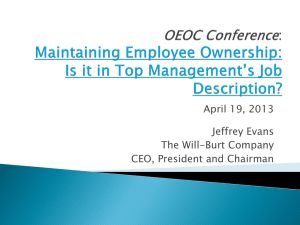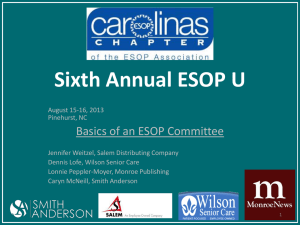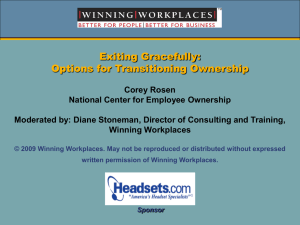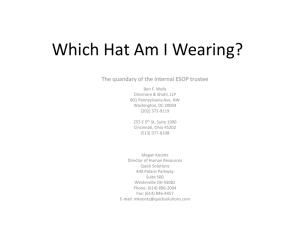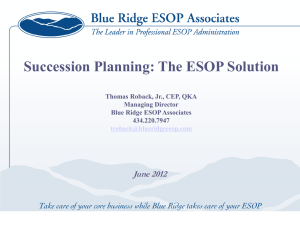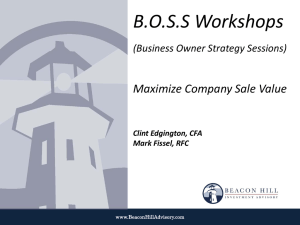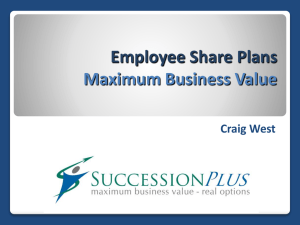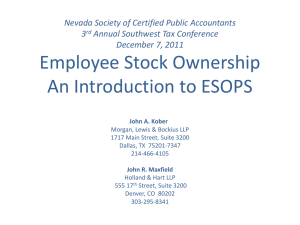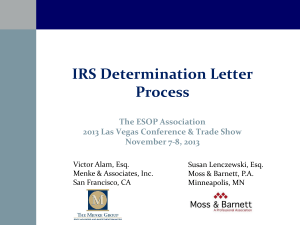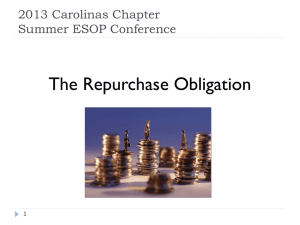Achieving the Performance Potential of Shared Ownership
advertisement
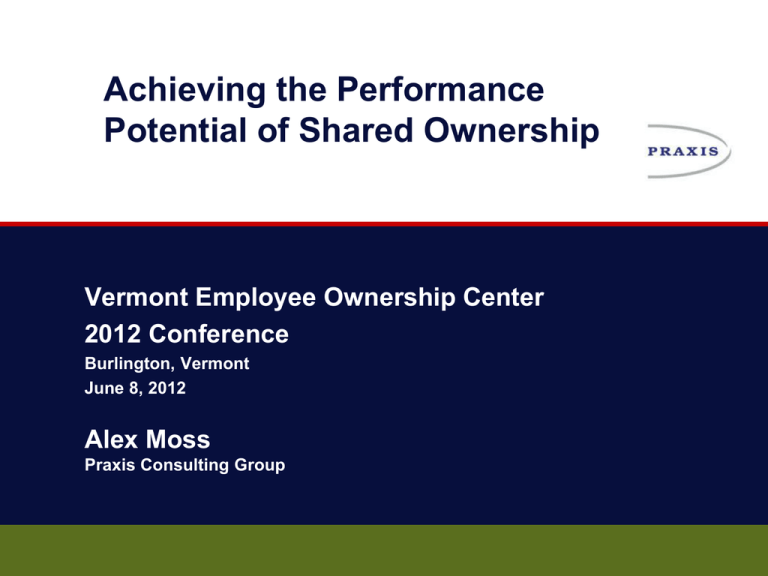
Achieving the Performance Potential of Shared Ownership Vermont Employee Ownership Center 2012 Conference Burlington, Vermont June 8, 2012 Alex Moss Praxis Consulting Group Organizational Performance Strategy High Performance Culture 1 Leadership VEOC Conference | EO Performance June 8, 2012 Agenda for Today Part 1: What’s Required, Why Do More? What company financial information do / should you share with employee-owners? Why? Discussion Part 2: How Can You Do It Effectively? Getting started: outline of a sample program Sample Exercises & Discussion Turning education into action: participation mechanisms 2 VEOC Conference | EO Performance June 8, 2012 What are Your Burning Issues? 3 Learn what I don’t know Magic potion Employee wants to do what she can to help Balancing rights and responsibilities Culture through rapid growth Help people believe there’s something of value to them, not just to sellers How to engage temporary employees to have a stake in ESOP Bounty for suggestions Community building in workforce Reengaging longer-term employees VEOC Conference | EO Performance June 8, 2012 Part 1: What’s Required, Why Do More? Legal requirements for financial disclosure Research on employee ownership and company performance Your company goals: what do you want “shared ownership” to do for you? 4 VEOC Conference | EO Performance June 8, 2012 Legal Disclosure Requirements: The Framework The ESOP Trustee is the legal “shareholder” ESOP Participants are “beneficiaries” of a benefit plan under ERISA 5 VEOC Conference | EO Performance June 8, 2012 ESOP Governance Shareholders ESOP Fiduciary Committee Individual Owners ESOP Trustees select are represented by ESOP Participants elect Board of Directors appoint and oversee CEO / President hire and oversee Leadership Team when meet eligibility requirements hire and oversee ESOP Communications Committee: Promote Ownership Employees 6 VEOC Conference | EO Performance June 8, 2012 Implications The ESOP Trustee receives all information that is disclosed to shareholders ESOP Participants have clear rights to view certain ESOP information ESOP Participants have very limited rights to view company financial information ESOP Participants have no operational management rights 7 VEOC Conference | EO Performance June 8, 2012 Why Go Beyond the Legal Requirements? Bottom line: employee-owned companies perform better Research supported by Employee Ownership Foundation GSS: layoffs during recent recession Blasi & Kruse: impact of employee ownership on company performance in privately-held firms National public opinion survey Other research: see NCEO summary Ownership culture: strategies to link the fact of ownership to actual performance improvements 8 VEOC Conference | EO Performance June 8, 2012 The Role of Employee Ownership: How does it add to the mix? Sharing ownership by itself does not improve company performance Sharing ownership combined with participation significantly improves decision making and bottom line performance Ownership Culture strategies link these two factors We wouldn’t be here if If couldn’t work If worked “automatically” 9 VEOC Conference | EO Performance June 8, 2012 Ownership Culture Running your company so that employees think, feel and act like co-owners Employees at all levels understand who decides what and why have access to structures, training, information and management support for participation participate actively, effectively and appropriately to continuously improve company performance 10 VEOC Conference | EO Performance June 8, 2012 How Do We Want Employees To Act: Ownership Behaviors “I’m going to do my own job really well & responsibly” “I’m going to react & respond to others in the firm in getting their jobs done” “I’m going to expect others to react and respond to my needs in doing my job well” “I’m going to think about the whole, understand the bigger picture” Courtesy of Don Hubbard, President, Niven Marketing 11 VEOC Conference | EO Performance June 8, 2012 Praxis’ Employee Ownership Performance Cycle TM Y o u r A c t i o n s Y o u r R e w a r d s 12 VEOC Conference | EO Performance C o m p a n y P e r f o r m a n c e June 8, 2012 Discussion Question 1: Link to Your Strategic Goals What are your strategic business objectives? What impact do you expect ownership to have in improving your company? How do you want employee owners to act, based on their increasing business knowledge? What information do you need employee owners to understand? Why? 13 VEOC Conference | EO Performance June 8, 2012 Discussion Question 2: Current Status How well do your employee owners understand the business and the financials? What impact has this had on your business so far? What are employee owners doing? What works best today: tell a story about… A specific company leader who “did it right” A specific employee-owner who demonstrated that they “get it” Impact of employee initiatives on performance – operating metrics, profitability, stock value 14 VEOC Conference | EO Performance June 8, 2012 Discussion Question 3: Future Vision Imagine that it’s 2015, and you are back at this conference sharing your achievements over the past couple years What have you accomplished? Leadership initiatives Employee actions The Gap: what do you need to do more of in your company to achieve this vision? 15 VEOC Conference | EO Performance June 8, 2012 Part 2, How: What are the Pieces? Context Setup Initial planning Initial education: building a knowledge foundation Operational implementation “Games” and other ongoing tools Process improvement initiatives Evaluation and continuous improvement Future adjustments 16 VEOC Conference | EO Performance June 8, 2012 Context: It’s a Whole Process Foundation: Leadership vision for how ownership should contribute to achieving strategic business objectives Making it work: 4 categories of activities Training, initial and ongoing – teach the rules Communication – show the score Incentives – share the win Participation mechanisms – let ‘em play 17 VEOC Conference | EO Performance June 8, 2012 Initial Education: Sample Goals To engage employees in learning about our business To build awareness of The connection between your actions, the outcomes for our company, and your rewards Business and financial terms, so that you can be effective consumers of financial information Pay for performance, and the stock component of this in particular How the ESOP works, especially in relation to other incentives and stock plans Balance between social responsibility and business objectives To create readiness and knowledge necessary for future implementation 18 VEOC Conference | EO Performance June 8, 2012 Common Approaches Focus on financial statements Start w/ dollar bill, carve up Profit & Loss, Balance Sheet, Cash Flow Case studies of where the numbers come from and how the statements relate to each other Examples Companies Commercial product example: the Accounting Game / Lemonade Stand 19 VEOC Conference | EO Performance June 8, 2012 Praxis Template Outline Initially: 3 sessions, 2½ hours each, 1x / month Session 1: Our Business, and How We Make Money Session 2: How You Benefit through Profit Sharing, Ownership, Retirement Plans, Other Incentives Session 3: Factors That Drive Our Stock Value, and What You Can Do To Affect It Future: additional sessions and continuing follow-up at departmental and corporate levels 20 VEOC Conference | EO Performance June 8, 2012 Agenda for Session 1 Income & expenses: the personal view Our business: the flow Our Profit & Loss statement (P&L): tracking whether and how we make money “What if?” scenarios: the impact of changes on our profits and stock value 21 VEOC Conference | EO Performance June 8, 2012 Exercise 1: Personal Income & Expenses Income 22 Expenses VEOC Conference | EO Performance June 8, 2012 Exercise 1: Personal Income & Expenses Two rounds Round 1: Personal, your home budget Round 2: Our Company Questions Where does the money come from? Where does it go? If there’s coming in than going out: what can you do with it, and how/when will you get it back? If not: what can you do about it? Who decides, and why? How does this relate to “value” and “wealth”? 23 VEOC Conference | EO Performance June 8, 2012 Exercise 2: The Flow of the Business Your basic business process: what are the steps? The exercise List functions & attach employee names Compare notes, pick 1 company [Make photos, big enough to handle: ~ 11x17] Put them in order Relate to the P&L 24 VEOC Conference | EO Performance June 8, 2012 Other Exercises in Session 1 Product P&L: big enough to count, small enough to understand Whole company P&L: sum of the parts “What if” scenarios: effect of operating improvements on the bottom line, hook to ongoing “games” 25 VEOC Conference | EO Performance June 8, 2012 Agenda for Session 2 ESOP & Benefit Sharing Overview: create it, share it How: Profit Sharing, Ownership, Retirement Plans, and Other Incentives Rules: how they work Valuation: what all these plans could be worth to you 26 VEOC Conference | EO Performance June 8, 2012 Agenda for Session 3 Our business strategy Our value proposition: why people buy products / services from us Our Strategic Plan: where we are headed Our stock value How the market / appraiser values our stock How you affect the value Where to from here What we want you to do: operating challenges & opportunities What other information you will receive: future education & communications Wrap up & graduation 27 VEOC Conference | EO Performance June 8, 2012 Other Sample Exercises Constructing the Balance Sheet Developing specific performance improvement targets Linking performance targets to the financial statements to individual rewards Reinvesting profits: Board of Directors exercise Profits, book value and market value Affect of investments, acquisitions, other growth strategies – long term risk & reward Future value illustrations (for ESOP, Profit Sharing and/or other contingent benefits) – sample employee and/or individual tool 28 VEOC Conference | EO Performance June 8, 2012 Keeping the Process Alive Core education/training program Targeted topics for leadership and/or “local” issues More big picture – our business strategy, and why More details – unit performance & improvement goals Repeat for new employees Adjust for new business / economic realities Regular communication of performance issues and results Participation structures so employees can use new information and knowledge to improve performance Integration with other short and mid-term incentives Follow up: “Building Long-Term Value: Developing a High-Performance Ownership Culture” 29 www.praxiscg.com/published-work/building-long-term-value-developing-high-performance-ownership-culture VEOC Conference | EO Performance June 8, 2012 Effective implementation requires: Accountability: whose job is it to oversee / insure success? Development: who will design it? Trainers: who will teach it? How will they learn? Reinforcement: link to ongoing distribution of key financial data Repetition: how often? Revision / continuous improvement: incorporating new learning and keeping it fresh over time 30 VEOC Conference | EO Performance June 8, 2012 Praxis’ Principles for Effective Business Literacy Development Simple Concrete Interactive Enjoyable Strategically integrated Developmental Just-in-time 31 VEOC Conference | EO Performance June 8, 2012 Discussion / Q&A Any unanswered questions? What makes this hard? Other best practices in your companies? What are your top recommendations – things you would do now, if you were starting from scratch, or things you wish you could do? 32 VEOC Conference | EO Performance June 8, 2012 Contact Information Alex Moss Praxis Consulting Group, Inc. 215.753.0304 alex@praxiscg.com 33 VEOC Conference | EO Performance June 8, 2012
